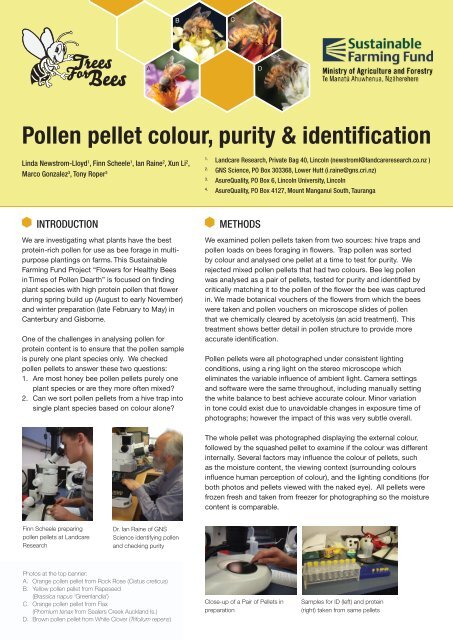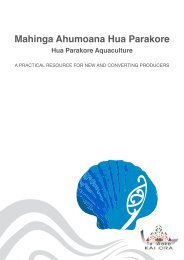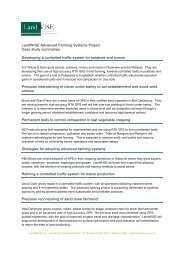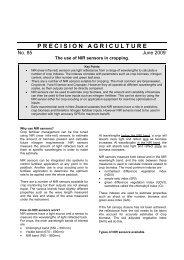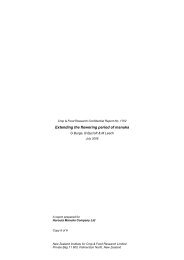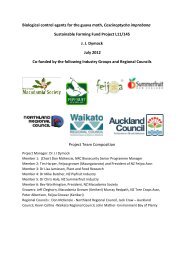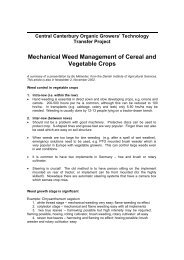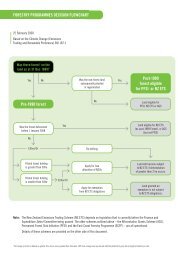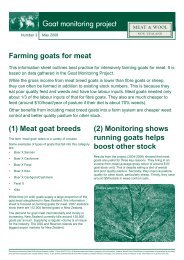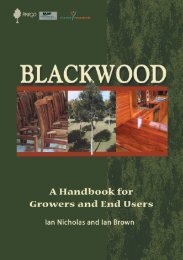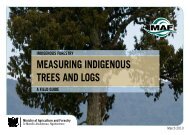Pollen pellet colour, purity & identification (PDF File ... - Trees for Bees
Pollen pellet colour, purity & identification (PDF File ... - Trees for Bees
Pollen pellet colour, purity & identification (PDF File ... - Trees for Bees
You also want an ePaper? Increase the reach of your titles
YUMPU automatically turns print PDFs into web optimized ePapers that Google loves.
BCAD<strong>Pollen</strong> <strong>pellet</strong> <strong>colour</strong>, <strong>purity</strong> & <strong>identification</strong>Linda Newstrom-Lloyd 1 , Finn Scheele 1 , Ian Raine 2 , Xun Li 2 ,Marco Gonzalez 3 , Tony Roper 31.Landcare Research, Private Bag 40, Lincoln (newstroml@landcareresearch.co.nz )2.GNS Science, PO Box 303368, Lower Hutt (i.raine@gns.cri.nz)3.AsureQuality, PO Box 6, Lincoln University, Lincoln4.AsureQuality, PO Box 4127, Mount Manganui South, TaurangaINTRODUCTIONWe are investigating what plants have the bestprotein-rich pollen <strong>for</strong> use as bee <strong>for</strong>age in multipurposeplantings on farms. This SustainableFarming Fund Project “Flowers <strong>for</strong> Healthy <strong>Bees</strong>in Times of <strong>Pollen</strong> Dearth” is focused on findingplant species with high protein pollen that flowerduring spring build up (August to early November)and winter preparation (late February to May) inCanterbury and Gisborne.One of the challenges in analysing pollen <strong>for</strong>protein content is to ensure that the pollen sampleis purely one plant species only. We checkedpollen <strong>pellet</strong>s to answer these two questions:1. Are most honey bee pollen <strong>pellet</strong>s purely oneplant species or are they more often mixed?2. Can we sort pollen <strong>pellet</strong>s from a hive trap intosingle plant species based on <strong>colour</strong> alone?METHODSWe examined pollen <strong>pellet</strong>s taken from two sources: hive traps andpollen loads on bees <strong>for</strong>aging in flowers. Trap pollen was sortedby <strong>colour</strong> and analysed one <strong>pellet</strong> at a time to test <strong>for</strong> <strong>purity</strong>. Werejected mixed pollen <strong>pellet</strong>s that had two <strong>colour</strong>s. Bee leg pollenwas analysed as a pair of <strong>pellet</strong>s, tested <strong>for</strong> <strong>purity</strong> and identified bycritically matching it to the pollen of the flower the bee was capturedin. We made botanical vouchers of the flowers from which the beeswere taken and pollen vouchers on microscope slides of pollenthat we chemically cleared by acetolysis (an acid treatment). Thistreatment shows better detail in pollen structure to provide moreaccurate <strong>identification</strong>.<strong>Pollen</strong> <strong>pellet</strong>s were all photographed under consistent lightingconditions, using a ring light on the stereo microscope whicheliminates the variable influence of ambient light. Camera settingsand software were the same throughout, including manually settingthe white balance to best achieve accurate <strong>colour</strong>. Minor variationin tone could exist due to unavoidable changes in exposure time ofphotographs; however the impact of this was very subtle overall.The whole <strong>pellet</strong> was photographed displaying the external <strong>colour</strong>,followed by the squashed <strong>pellet</strong> to examine if the <strong>colour</strong> was differentinternally. Several factors may influence the <strong>colour</strong> of <strong>pellet</strong>s, suchas the moisture content, the viewing context (surrounding <strong>colour</strong>sinfluence human perception of <strong>colour</strong>), and the lighting conditions (<strong>for</strong>both photos and <strong>pellet</strong>s viewed with the naked eye). All <strong>pellet</strong>s werefrozen fresh and taken from freezer <strong>for</strong> photographing so the moisturecontent is comparable.Finn Scheele preparingpollen <strong>pellet</strong>s at LandcareResearchDr. Ian Raine of GNSScience identifying pollenand checking <strong>purity</strong>Photos at the top banner:A. Orange pollen <strong>pellet</strong> from Rock Rose (Cistus creticus)B. Yellow pollen <strong>pellet</strong> from Rapeseed(Brassica napus ‘Greenlandia’)C. Orange pollen <strong>pellet</strong> from Flax(Phomium tenax from Sealers Creek Auckland Is.)D. Brown pollen <strong>pellet</strong> from White Clover (Trifolium repens)Close-up of a Pair of Pellets inpreparationSamples <strong>for</strong> ID (left) and protein(right) taken from same <strong>pellet</strong>s
PURITYQuestion 1: Are most honey bee pollen <strong>pellet</strong>s purely one plant species?When sorting hive trap pollen, we found that the majority of pollen <strong>pellet</strong>s are purely one <strong>colour</strong>. We rejected less than 1% of the<strong>pellet</strong>s as mixed pollen with two contrasting <strong>colour</strong>s (See examples in Photos 1 and 2). Some pollen <strong>colour</strong>s are highly distinctiveand very uncommon such as the red pollen of Horse Chestnut (PHOTO 3) and brown pollen of white clover (PHOTO D, above).Some <strong>colour</strong>s are found in only a few plant species such as the purple (mauve) pollen of Phacelia (Photo 4), a <strong>colour</strong> also found inFuchsia and some Thistles.Hodges (1974) reports that when bees <strong>for</strong>age on two different plants producing a mixed <strong>pellet</strong>, the pattern of <strong>colour</strong>s is usuallyhalf and half mixed because of the way that bees visit flowers in a sequence. How then do we explain the case of Flax (PHOTO5) where two distinct pollen <strong>colour</strong>s <strong>for</strong>m a spiral pattern? No this pattern is not from a dizzy bee <strong>for</strong>aging, it is derived from themixture in the flax anther of orange and yellow pollen. We know this pollen is purely flax because we checked acetolysed pollendirectly from the flower and matched it to that from bee legs. This mix of two <strong>colour</strong>s in flax anthers is confirmed in the literature(Craig & Stewart 1988) and by direct examination of pollen in the anthers under the stereo microscope.We were not able to judge <strong>purity</strong> from <strong>pellet</strong> <strong>colour</strong> when the pollen <strong>colour</strong> of two different plant species is very similar. Forexample, we found a white <strong>pellet</strong> from a bee seen visiting an Ash flower that was mixed with primarily Hawthorn pollen and onlysome Ash (Photo 6). During work in progress we have found only one single <strong>colour</strong> mixed <strong>pellet</strong> out of over 30 pollen <strong>pellet</strong>samples examined <strong>for</strong> <strong>purity</strong> by microscopic analysis of acetolysed pollen.1 23 4Mixed <strong>pellet</strong>s with contrasting <strong>colour</strong>sHorse chestnut(Aesculushippocastanum)Phacelia (Phacelia tanecetifolia)5 6Not Mixed: Yellow and Orangepollen <strong>pellet</strong> of Flax (Phormiumcookianum ‘Tri<strong>colour</strong>’)Mixed: White pollen <strong>pellet</strong>of Hawthorn (Crataegusmonogyna) mixed with MannaAsh (Fraxinus ornus)
Polar Equat. <strong>Pollen</strong> Pellets <strong>Pollen</strong> Pellets Equat. Polar121314151617Colour B: Yellow OrangePhoto 12: Tree Peony (Paeonia suffruticosa); Photo 13: Flowering cherry (Prunus sp.);Photo 14: Camellia (Camellia japonica ‘Flame’);Photo 15: Willow (Salix sp.); Photo 16: Ivy (Hedera helix);Photo 17: Black Boy Peach (Prunus persica ‘Black Boy’)
Polar Equat. <strong>Pollen</strong> Pellets <strong>Pollen</strong> Pellets Equat. Polar181920212223Colour C: Whitish BeigePhoto 18: Rosemary (Rosmarinus officinalis); Photo 19: Thyme (Thymus vulgaris);Photo 20: Borage (Borago officinalis);Photo 21: Silver Bush (Convolvulus cneorum); Photo 22: Koromiko (Hebe sp.);Photo 23: Poppy (Papaver somniferum)
WHAT OTHER INFORMATIONCAN BE USED TO HELPWITH PURITY ANDIDENTIFICATION?Experienced beekeepers can often tell the identity of a pollen <strong>pellet</strong> ona bee or from a hive trap based on their knowledge of what is floweringwithin a 2 to 5 km radius of their apiary at the time the pollen <strong>pellet</strong> wascollected. This will work well <strong>for</strong> pollen <strong>colour</strong>s that are distinctive andrare such as brown clover pollen <strong>pellet</strong>s (PHOTO D) or red horse chestnutpollen <strong>pellet</strong>s (PHOTO 3). In the case of purple or mauve pollen, there arethree possibilities: phacelia, thistle, or fuchsia but some of these can beeliminated because they are not flowering at that time or the beekeeperknows that that plant species does not grow in the area.Additional features of the pollen <strong>pellet</strong> can be used as well. For example, inthe case of Brassica and Walnut which are a very similar yellow, the surfacetexture looks slightly different. When the pollen <strong>pellet</strong> is squashed Brassicais dry and crumbly (PHOTO 24) while Walnut is sticky (PHOTO 25).2425SUMMARY &CONCLUSIONSEven though we reject all obviously mixed pollen <strong>pellet</strong>s (two <strong>colour</strong>ed),the <strong>purity</strong> of pollen still needs to be checked under the microscope usingacetolysed pollen because it is possible that a single <strong>colour</strong>ed pollen <strong>pellet</strong>can consist of two or more plant species but this is quite rare. Since somany plant species share the same <strong>colour</strong> of pollen we cannot combine<strong>pellet</strong>s <strong>for</strong> the protein analysis. We must analyse pollen using only one <strong>pellet</strong>at a time <strong>for</strong> hive trap pollen or using a pair of <strong>pellet</strong>s from only one bee at atime. Such small samples, often less than .5 mg, are analysed byDr. Karyne Rogers at GNS Science lab. We control <strong>for</strong> <strong>purity</strong> by examiningthe associated voucher of acetolysed pollen taken from the same <strong>pellet</strong> asthe one sent <strong>for</strong> protein analysis.During this examination process, the <strong>identification</strong> of pollen from samplestaken from bees visiting flowers is facilitated by critically matching it to thepollen taken directly from the flowers the bee was <strong>for</strong>aging in. Hive trappollen however, is more difficult as it requires other supporting in<strong>for</strong>mation<strong>for</strong> pollen <strong>identification</strong>, such as knowing what species are in flower inthe area at the time the hive trap pollen was taken but this is not alwaysavailable especially if the bees are <strong>for</strong>aging at a great distance.
REFERENCESHodges D 1974. The <strong>Pollen</strong> Loads of the Honey Bee, Bee Research Institute, Nature - 65 pagesCraig JL and Stewart AM 1988. Reproductive biology of Phormium tenax: A honeyeater-pollinatedspecies. New Zealand Journal of Botany 26(3): 453-463. <strong>Pollen</strong> described on Page 456.ACKNOWLEDGMENTSThis project is funded by the Ministry of Agriculture and Forestry Sustainable Farming Fund Project 10/009and a number of co-funding sponsors listed on our website at www.trees<strong>for</strong>beesnz.org. The work wasconducted by scientists at Landcare Research, AsureQuality and GNS Science and is part of the OceaniaPollinator Initiative Program.


